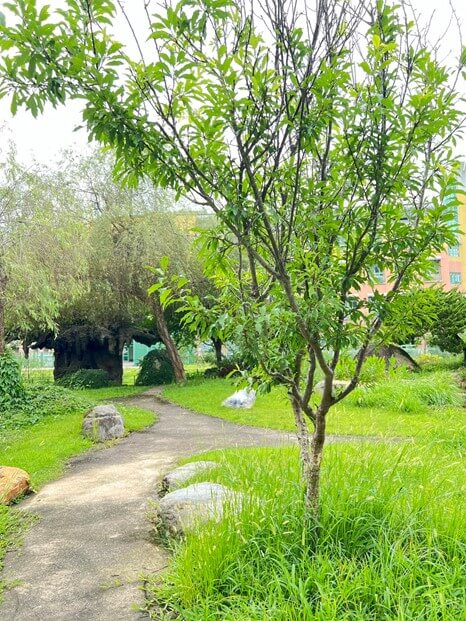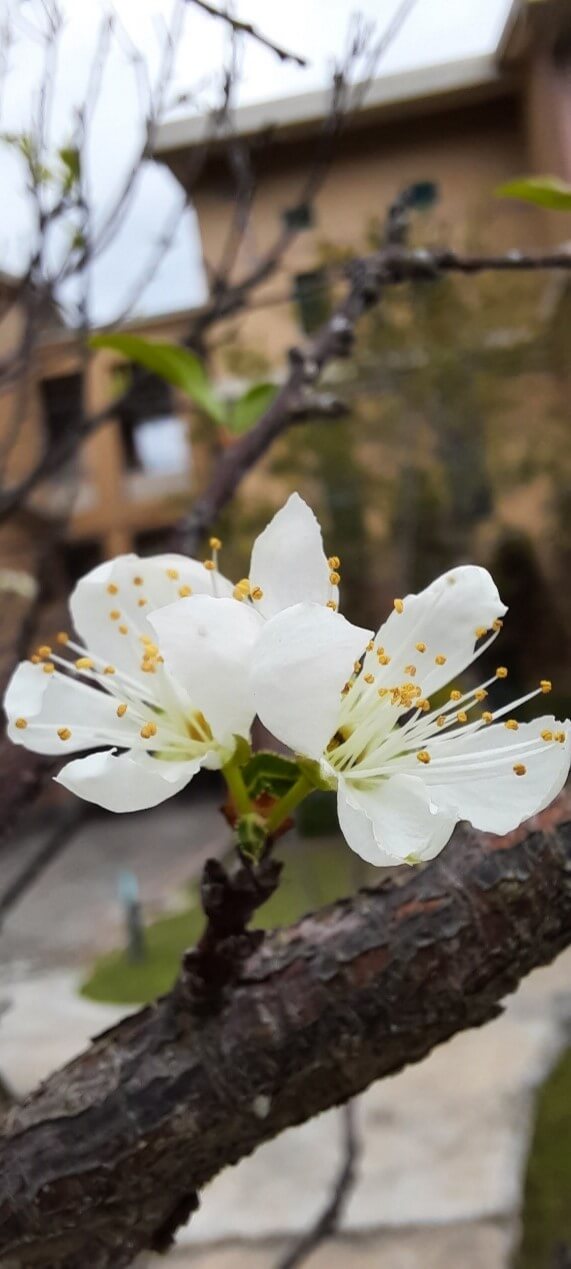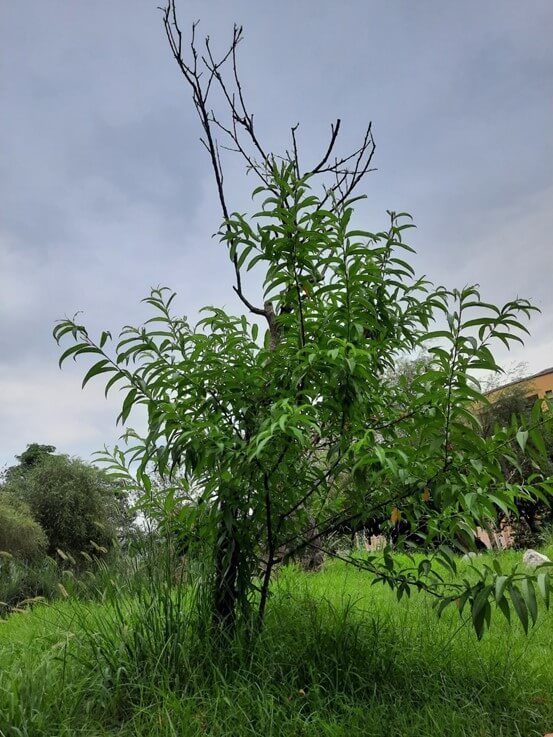春三二月天
——古典櫻‧桃詩
朱嘉雯
Spring in the Second and Third Months---
Classical Cherry Blossom and Peach Poetry
By Chu Chia-Wen
 李樹
李樹
 李花
李花
 櫻花樹
櫻花樹
 桃樹
桃樹
細雨絲絲落入芳草地,點點敲打在水塘波面,那揉入春泥的水,是枝頭花苞的甘露靈泉,潤澤了即將綻放的新生命。
Fine raindrops fall gently onto the fragrant grassland, tapping lightly on the surface of the pond, mingling with the spring mud. This water, infused with the essence of flower buds, serves as the sweet dew of life, nourishing the imminent blossoming of new life.
「詩經花園」繼梅花飄香,瀟灑如雪之後,櫻花與桃花已冒出了紅苞。古人詩詞中常將櫻、桃並稱,該是讚賞春天處處紅馥豔香,以致於陶醉在花海中,分不清櫻、桃、杏、李了。李白《久別離》詩云:「別來幾春未還家,玉窗五見櫻桃花。」同為唐代詩人的張籍,有《和裴僕射看櫻桃花》:「昨日南園新雨後,櫻桃花發舊枝柯。」他在《雨中寄元宗簡》中也說:「東風漸暖滿城春,獨占幽居養病身。莫說櫻桃花已發,今年不作看花人。」
In the "Poetry Garden," after the fragrance of plum blossoms drifting gracefully like snow, cherry blossoms and peach blossoms have now burst into red buds. In ancient poetry, cherry and peach blossoms are often mentioned together. Perhaps the vibrant beauty and fragrance of spring in a sea of flowers make one unable to distinguish between cherry, peach, apricot, and plum. Li Bai, the well-known poet in the Tang Dynasty, wrote in his poem "Long Parting": "After several springs of separation, I have not yet returned home. Through the jade window, I've seen cherry and peach blossoms five times." Similarly, Zhang Ji, another poet in the Tang dynasty, wrote in "On Viewing Cherry Blossoms with the Minister Pai": "Yesterday, after the new rain in the southern garden, cherry blossoms bloomed on the old branches." In his poem "Sending a Letter to Yuan Zongjian in the Rain," he also said: "As the east wind gradually warms, spring fills the entire city. I am alone in my secluded dwelling, nursing my illness. Don't say that the cherry blossoms have already bloomed; this year, I won't be one of those who go out to admire the flowers."
不僅古詩詞中櫻與桃並舉,有時櫻、桃也與杏花融為一片。明代于若瀛的《櫻桃花》詩:「三月雨聲細,櫻花疑杏花。」而最能以櫻花桃花寄託相思之情的,還是元稹所作《折枝花贈行》:「櫻桃花下送君時,一寸春心逐折枝。別後相思最多處,千株萬片繞林垂。」元稹的家族源於北魏鮮卑族皇室,然而說他是歷史上最能以漢家詩文寄托相思的人,也並不為過。著名的《離思》:「曾經滄海難為水,除卻巫山不是雲。取次花叢懶回顧,半緣修道半緣君。」已說明了一切。
Not only are cherry and peach blossoms often paired in ancient poetry, sometimes cherry, peach, and apricot blossoms are mentioned together as well. In the Ming Dynasty, Yu Ruoying wrote in his poem "Cherry Blossoms": "In March, the rain is light, and cherry blossoms resemble apricot blossoms." However, perhaps the most poignant expression of longing using cherry and peach blossoms is found in Yuan Zhen's poem "Sending Branches of Flowers as a Farewell Gift": "Under the cherry and peach blossoms, I bid you farewell. An inch of springtime sentiment clings to each broken branch. After parting, the most frequent place of longing is among the thousand trees and myriad petals, draping the forest." Yuan Zhen's family originated from the royal family of the Xianbei tribe in the Northern Wei Dynasty. However, it is not an exaggeration to say that he was the person in history who best expressed longing through Han-style poetry and prose. His famous poem "Parting Thoughts" reads: "Once, the ocean was difficult to measure with water; now, nothing but the Wushan Mountains are beyond the clouds. Passing through the flowers, I lazily look back, halfway to enlightenment, halfway to you," which expresses everything.
其實櫻、桃、杏、李在詩歌的花園裡不分彼此,兩兩相互並稱,這樣的文學現象,皆紹述於《詩經》。《詩經 . 召南 . 何彼襛矣》:「何彼襛矣,華如桃李。」另《詩經 . 國風·王風·丘中有麻》:「丘中有李,彼留之子。彼留之子,貽我佩玖。」詩中寫道,在春風沉醉的花樹林下,桃花嬌紅,李花純淨,兩情相悅的情侶於落英紛飛的花雨中,情思婉轉,贈玉定情。詩人以天地之大美,作為相思情濃的戀愛聖地,這又是《詩經》各地國風 所留下的民族文學主旋律。
In the poetic garden of the "Book of Odes and Hymns," cherry, peach, apricot, and plum blossoms are often mentioned together, with pairs of them being intertwined and mentioned interchangeably. This literary phenomenon is exemplified in the "Book of Odes and Hymns." In the poem "He Bi Nong" from the "Shao Nan" section, it reads: "How lush and luxuriant they are, their splendor akin to peach and plum blossoms." Another example is found in the "Guo Feng - Wang Feng - Qiu Zhong You Ma" poem: "Amidst the hills, there are plum trees, where a certain young man lingers. That lingering young man presented me with a token." The poem depicts beneath the blossoming trees intoxicated by the spring breeze, where peach blossoms are rosy and plum blossoms are pure. In the midst of falling petals, the lovers exchange their heartfelt emotions, sealing their affection with the gift of jade. The poet portrays the beauty of nature as a sacred place for deep affection, reflecting the ethnic literary theme left by various local styles of the "Book of Odes and Hymns."
「開闢鴻蒙,誰為情種?都只為風月情濃。」雖說「恰三春好處無人見」,然而每到春來,桃飄李飛,櫻雨杏芬,依舊在風雨年華裡,紅消香斷,落絮輕沾,游絲軟繫,織就了渺渺茫茫、夢幻迷離的愛情之網,從《詩經》以降,歷經唐宋詩詞,直到《牡丹亭》、《紅樓夢》,教我們過目難忘。於是到頭來,誰都別想逃離春天。
"In the vast expanse of creation, who planted the seeds of love? It is all for the sake of the deep emotions stirred by the beauty of nature." Although "the best of spring's joys often go unnoticed," yet every spring, with peach blossoms fluttering and plum blossoms flying, cherry blossoms raining down and apricot blossoms wafting their fragrance, amidst the winds and rains of the passing years, the red fades and the fragrance dissipates. Petals fall lightly, brushing gently against the ground, while delicate threads weave a vast, dreamlike web of love. From the "Book of Odes and Hymns " onwards, through the poetry of the Tang and Song dynasties, to works like "The Peony Pavilion" and "Dream of the Red Chamber," spring's allure is unforgettable. In the end, no one can escape from spring.


